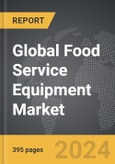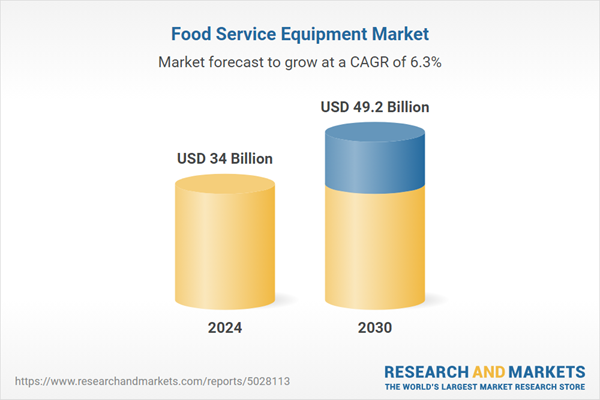The global market for Food Service Equipment was valued at US$34.0 Billion in 2024 and is projected to reach US$49.2 Billion by 2030, growing at a CAGR of 6.3% from 2024 to 2030. This comprehensive report provides an in-depth analysis of market trends, drivers, and forecasts, helping you make informed business decisions. The report includes the most recent global tariff developments and how they impact the Food Service Equipment market.
Key trends in the food service equipment market highlight a significant shift towards sustainability and automation. As environmental concerns grow, there is an increasing demand for eco-friendly equipment that minimizes energy consumption and reduces carbon footprints. Manufacturers are responding by producing equipment with advanced energy-saving features and using recyclable materials. Additionally, the rise of automated kitchen solutions, including robotic chefs and automated ordering systems, reflects the industry's adaptation to labor shortages and the need for consistency in food quality. These advancements not only streamline operations but also enhance the customer dining experience by ensuring faster service and precise food preparation. The trend towards customization and flexibility in equipment design allows establishments to tailor their kitchen layouts and operations to meet specific culinary needs and consumer preferences.
The growth in the food service equipment market is driven by several factors. Rapid urbanization and changing consumer preferences are driving the proliferation of food service businesses, driving demand for food service equipment. In addition to the demand for equipment from new establishments, replacement demand also accounts for a significant share of the food service equipment market. The health scares in the recent past have driven the focus of regulators on food safety, necessitating investments in new and advanced equipment. In addition, the focus on energy efficiency to fight against greenhouse gas emissions is also driving replacement demand for food service equipment.
Technological advancements play a significant role, with innovations such as IoT-enabled devices and smart kitchen solutions enhancing operational efficiency and offering predictive maintenance capabilities. The increasing popularity of food delivery services and the proliferation of cloud kitchens necessitate specialized equipment designed for high-volume, rapid food preparation and delivery. Consumer behavior also influences market growth, as there is a rising preference for dining out and experiencing diverse culinary options, prompting restaurants to invest in advanced equipment to meet customer expectations. Furthermore, stringent food safety regulations and standards compel food service operators to upgrade to equipment that ensures compliance and enhances hygiene. These factors collectively contribute to the dynamic expansion of the food service equipment market, positioning it for continued growth and innovation.
Segments: Product (Cooking Equipment, Storage & Handling Equipment, Warewashing Equipment, Food & Beverage Preparation Equipment, Other Products); End-Use (Full-Service Restaurants & Hotels, Quick-Service Restaurants & Pubs, Other End-Uses).
Geographic Regions/Countries: World; USA; Canada; Japan; China; Europe; France; Germany; Italy; UK; Spain; Russia; Rest of Europe; Asia-Pacific; Australia; India; South Korea; Rest of Asia-Pacific; Latin America; Argentina; Brazil; Mexico; Rest of Latin America; Middle East; Iran; Israel; Saudi Arabia; UAE; Rest of Middle East; Africa.
The analysts continuously track trade developments worldwide, drawing insights from leading global economists and over 200 industry and policy institutions, including think tanks, trade organizations, and national economic advisory bodies. This intelligence is integrated into forecasting models to provide timely, data-driven analysis of emerging risks and opportunities.
Global Food Service Equipment Market - Key Trends & Drivers Summarized
Food service equipment encompasses a broad range of tools and machinery essential for the efficient operation of commercial kitchens and food service establishments. These include cooking appliances such as ovens, grills, and fryers, as well as refrigeration units, dishwashers, food preparation tools, and storage solutions. Modern food service equipment is designed to enhance the speed and quality of food preparation, ensuring that meals are served hot, fresh, and in a timely manner. Innovations in this sector have led to the development of energy-efficient and multifunctional appliances that cater to the diverse needs of restaurants, hotels, cafeterias, and catering services. The integration of smart technology into food service equipment has revolutionized kitchen operations, providing real-time monitoring and control over various processes, thereby reducing waste and improving overall efficiency.Key trends in the food service equipment market highlight a significant shift towards sustainability and automation. As environmental concerns grow, there is an increasing demand for eco-friendly equipment that minimizes energy consumption and reduces carbon footprints. Manufacturers are responding by producing equipment with advanced energy-saving features and using recyclable materials. Additionally, the rise of automated kitchen solutions, including robotic chefs and automated ordering systems, reflects the industry's adaptation to labor shortages and the need for consistency in food quality. These advancements not only streamline operations but also enhance the customer dining experience by ensuring faster service and precise food preparation. The trend towards customization and flexibility in equipment design allows establishments to tailor their kitchen layouts and operations to meet specific culinary needs and consumer preferences.
The growth in the food service equipment market is driven by several factors. Rapid urbanization and changing consumer preferences are driving the proliferation of food service businesses, driving demand for food service equipment. In addition to the demand for equipment from new establishments, replacement demand also accounts for a significant share of the food service equipment market. The health scares in the recent past have driven the focus of regulators on food safety, necessitating investments in new and advanced equipment. In addition, the focus on energy efficiency to fight against greenhouse gas emissions is also driving replacement demand for food service equipment.
Technological advancements play a significant role, with innovations such as IoT-enabled devices and smart kitchen solutions enhancing operational efficiency and offering predictive maintenance capabilities. The increasing popularity of food delivery services and the proliferation of cloud kitchens necessitate specialized equipment designed for high-volume, rapid food preparation and delivery. Consumer behavior also influences market growth, as there is a rising preference for dining out and experiencing diverse culinary options, prompting restaurants to invest in advanced equipment to meet customer expectations. Furthermore, stringent food safety regulations and standards compel food service operators to upgrade to equipment that ensures compliance and enhances hygiene. These factors collectively contribute to the dynamic expansion of the food service equipment market, positioning it for continued growth and innovation.
Report Scope
The report analyzes the Food Service Equipment market, presented in terms of units. The analysis covers the key segments and geographic regions outlined below.Segments: Product (Cooking Equipment, Storage & Handling Equipment, Warewashing Equipment, Food & Beverage Preparation Equipment, Other Products); End-Use (Full-Service Restaurants & Hotels, Quick-Service Restaurants & Pubs, Other End-Uses).
Geographic Regions/Countries: World; USA; Canada; Japan; China; Europe; France; Germany; Italy; UK; Spain; Russia; Rest of Europe; Asia-Pacific; Australia; India; South Korea; Rest of Asia-Pacific; Latin America; Argentina; Brazil; Mexico; Rest of Latin America; Middle East; Iran; Israel; Saudi Arabia; UAE; Rest of Middle East; Africa.
Key Insights:
- Market Growth: Understand the significant growth trajectory of the Cooking Equipment segment, which is expected to reach US$15.9 Billion by 2030 with a CAGR of a 6.6%. The Storage & Handling Equipment segment is also set to grow at 7.0% CAGR over the analysis period.
- Regional Analysis: Gain insights into the U.S. market, valued at $10.1 Billion in 2024, and China, forecasted to grow at an impressive 8.3% CAGR to reach $8.4 Billion by 2030. Discover growth trends in other key regions, including Japan, Canada, Germany, and the Asia-Pacific.
Why You Should Buy This Report:
- Detailed Market Analysis: Access a thorough analysis of the Global Food Service Equipment Market, covering all major geographic regions and market segments.
- Competitive Insights: Get an overview of the competitive landscape, including the market presence of major players across different geographies.
- Future Trends and Drivers: Understand the key trends and drivers shaping the future of the Global Food Service Equipment Market.
- Actionable Insights: Benefit from actionable insights that can help you identify new revenue opportunities and make strategic business decisions.
Key Questions Answered:
- How is the Global Food Service Equipment Market expected to evolve by 2030?
- What are the main drivers and restraints affecting the market?
- Which market segments will grow the most over the forecast period?
- How will market shares for different regions and segments change by 2030?
- Who are the leading players in the market, and what are their prospects?
Report Features:
- Comprehensive Market Data: Independent analysis of annual sales and market forecasts in US$ Million from 2024 to 2030.
- In-Depth Regional Analysis: Detailed insights into key markets, including the U.S., China, Japan, Canada, Europe, Asia-Pacific, Latin America, Middle East, and Africa.
- Company Profiles: Coverage of players such as AB Electrolux, Dover Corporation, Duke Manufacturing Co., Fagor Industrial, S.Coop., Hubert Company, LLC and more.
- Complimentary Updates: Receive free report updates for one year to keep you informed of the latest market developments.
Some of the 739 companies featured in this Food Service Equipment market report include:
- AB Electrolux
- Dover Corporation
- Duke Manufacturing Co.
- Fagor Industrial, S.Coop.
- Hubert Company, LLC
- Hoshizaki Corp.
- Kiremko BV
- Marel
- The Middleby Corporation
- Smeg S.p.A.
Tariff Impact Analysis: Key Insights for 2025
Global tariff negotiations across 180+ countries are reshaping supply chains, costs, and competitiveness. This report reflects the latest developments as of April 2025 and incorporates forward-looking insights into the market outlook.The analysts continuously track trade developments worldwide, drawing insights from leading global economists and over 200 industry and policy institutions, including think tanks, trade organizations, and national economic advisory bodies. This intelligence is integrated into forecasting models to provide timely, data-driven analysis of emerging risks and opportunities.
What’s Included in This Edition:
- Tariff-adjusted market forecasts by region and segment
- Analysis of cost and supply chain implications by sourcing and trade exposure
- Strategic insights into geographic shifts
Buyers receive a free July 2025 update with:
- Finalized tariff impacts and new trade agreement effects
- Updated projections reflecting global sourcing and cost shifts
- Expanded country-specific coverage across the industry
Table of Contents
I. METHODOLOGYII. EXECUTIVE SUMMARY2. FOCUS ON SELECT PLAYERSIII. MARKET ANALYSISCANADAITALYSPAINRUSSIAREST OF EUROPESOUTH KOREAREST OF ASIA-PACIFICARGENTINABRAZILMEXICOREST OF LATIN AMERICAIRANISRAELSAUDI ARABIAUNITED ARAB EMIRATESREST OF MIDDLE EASTIV. COMPETITION
1. MARKET OVERVIEW
3. MARKET TRENDS & DRIVERS
4. GLOBAL MARKET PERSPECTIVE
UNITED STATES
JAPAN
CHINA
EUROPE
FRANCE
GERMANY
UNITED KINGDOM
ASIA-PACIFIC
AUSTRALIA
INDIA
LATIN AMERICA
MIDDLE EAST
AFRICA
Companies Mentioned (Partial List)
A selection of companies mentioned in this report includes, but is not limited to:
- AB Electrolux
- Dover Corporation
- Duke Manufacturing Co.
- Fagor Industrial, S.Coop.
- Hubert Company, LLC
- Hoshizaki Corp.
- Kiremko BV
- Marel
- The Middleby Corporation
- Smeg S.p.A.
Table Information
| Report Attribute | Details |
|---|---|
| No. of Pages | 395 |
| Published | April 2025 |
| Forecast Period | 2024 - 2030 |
| Estimated Market Value ( USD | $ 34 Billion |
| Forecasted Market Value ( USD | $ 49.2 Billion |
| Compound Annual Growth Rate | 6.3% |
| Regions Covered | Global |









